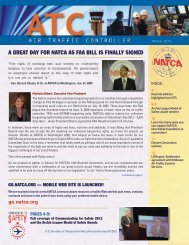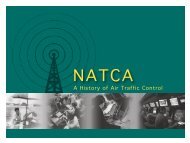Against the Wind - National Air Traffic Controllers Association
Against the Wind - National Air Traffic Controllers Association
Against the Wind - National Air Traffic Controllers Association
You also want an ePaper? Increase the reach of your titles
YUMPU automatically turns print PDFs into web optimized ePapers that Google loves.
Picketers congregated on <strong>the</strong> driveway of <strong>the</strong><br />
fire station across <strong>the</strong> street from Chicago Center in<br />
suburban Aurora, Illinois, shouting at co-workers<br />
and running out to kick <strong>the</strong> tires of <strong>the</strong>ir cars. At<br />
Houston Center, some 140 strikers yelled and waved<br />
signs while clustered along <strong>the</strong> grassy median of busy<br />
JFK Boulevard in front of <strong>the</strong> facility. At Salt Lake<br />
Center, managers stood on <strong>the</strong> roof, peered through<br />
binoculars, and wrote down picketers’ names.<br />
The tension outside yielded to different, yet<br />
equally charged, emotions inside. Some strikebreakers<br />
fretted about dealing with <strong>the</strong>ir colleagues<br />
when <strong>the</strong>y came back. O<strong>the</strong>rs were glad to be rid of<br />
<strong>the</strong>m—even if only temporarily. The stress during<br />
<strong>the</strong> preceding months, fueled by peer pressure and<br />
uncertainty, had swelled like a volcano on <strong>the</strong> verge<br />
of eruption.<br />
Yet, <strong>the</strong> strike resulted in one very pleasant<br />
consequence for those on <strong>the</strong> job. As never before,<br />
controllers, managers, staff specialists, and <strong>Air</strong>ways<br />
Facilities technicians set aside antagonism, pettiness,<br />
and class distinctions. Instead, <strong>the</strong>y banded toge<strong>the</strong>r<br />
with a sorely needed esprit de corps to keep <strong>the</strong> traffic<br />
moving.<br />
“For <strong>the</strong> first week, people were just operating<br />
on guts,” says Howie Barte, a controller at Quonset<br />
TRACON, south of Providence, Rhode Island. “It was<br />
<strong>the</strong> Alamo and we were loving it.”<br />
Initially, traffic was relatively light, leading one<br />
4<br />
Sep.<br />
The FAA announces it will hire about 1,500 temporary workers, including<br />
furloughed airline pilots, to serve as flight data assistants and perform<br />
o<strong>the</strong>r controller support functions.<br />
wag to declare: “We’re going to have one-state separation<br />
between airplanes.”<br />
To handle <strong>the</strong> gradual resumption of flights,<br />
bosses turned pragmatic and abandoned cumbersome<br />
operating procedures. Ra<strong>the</strong>r than haranguing<br />
controllers about phraseology errors, managers did<br />
whatever <strong>the</strong>y could to help, even ordering in food.<br />
Indeed, coffee and snacks were verboten in control<br />
rooms before <strong>the</strong> strike. Now <strong>the</strong>y were a necessity.<br />
The only breaks <strong>the</strong> skeletal work force enjoyed were<br />
dashes to <strong>the</strong> restroom. O<strong>the</strong>r rules were relaxed and<br />
Chapter 2: Opportunity Lost<br />
Japphire<br />
Houston Center: Nearly all of <strong>the</strong> FAA’s en route centers were built from <strong>the</strong> same cookie-cutter blueprint. The agency<br />
opted for a different design at its Houston facility, however, due to <strong>the</strong> influence of Lady Bird Johnson.<br />
33




